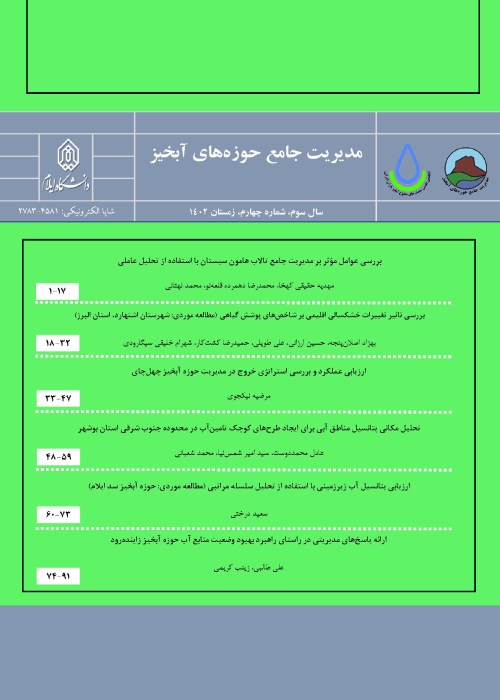Monitoring the spatial and temporal changes of floods and water bodies using indicators extracted from the Landsat satellite (Case study: Southwest Iran)
Extended AbstractIntroductionMapping and assessment of surface water dynamics is essential for continuous monitoring of water resources as it has significant implications in engineering and scientific research for floodplain delineation, wetlands, disaster management, biodiversity, climate change, and water resource management (Huang et al., 2018; Jawak et al., 2015). Traditional surface water monitoring methods mainly rely on field surveys or on established measuring stations. Although the accuracy of the data obtained by this method is high, it is time-consuming and has low efficiency. In addition, many aquifers are very difficult to access because they are located in remote and rugged places, and only data from limited points in incomplete time series are obtained due to the limitations of economic and land factors (Ogilvie et al., 2018). With the expansion and development of remote sensing science and geographic information system, better ways have been provided to monitor water bodies in a long period such that the use of multispectral satellite images and different spectral indices for monitoring water bodies and floods is a fast and economical method in terms of time and cost. The high number of existing sensors and their differences in estimating the spectral and spatial characteristics of spectral indices have led to a good representation of the potential and limitations of satellite data. Therefore, in this research, to investigate the flood of 2019 in the southwest of Iran, the Modified Normalized Difference Water Index (MNDWI) and the Normalized Diference Vegetation Index (NDVI) obtained from the Landsat 8 satellite images were used.Materials and MethodsThe study area is a part of the southwest of Iran, which includes the southern part of Ilam province and the northern, northwestern, western and southwestern parts of Khuzestan province. In this study, to investigate the flood of 2018-2019, Landsat 8 sensor images were used for three months of January, February and March in 2019. This section used QGis3.28, GIS10.8, Excel software and remote sensing data including satellite images related to Landsat 8 sensor. These multispectral data were obtained from the United States Geology website (earthexplorer.usgs.gov) and were prepared for preprocessing and necessary processing. To prepare a map of the flood area and vegetation, radiometric and atmospheric corrections were performed on the received images (Eskandari Damaneh et al., 2016). After applying the necessary pre-processing, the MNDWI and NDVI were used to prepare the map of changes in water bodies and vegetation for the years 2018 and 2019, respectively (Rugel et al., 2017; Abutaleb et al., 2015; Arekhi et al., 2019).ResultsAccording to the results, the highest values of MNDWI in 2018 corresponded to those on March 12, which includes the northern and central parts. In 2019, the highest value of this index was on the date of March 19, which included the southern to southwestern parts of the study area. Examining the changes in MNDWI classes showed that in 2019, on February 2nd, 19th and March 7th, classes ranging from 0.11 to 0.15 occupied the highest level of the studied range, which is more than 68.75 percent of the area. This range and its trend were increasing. On the other hand, on the mentioned dates, classes ranging from 0.15 to 0.2 covered an area of more than 24.32% of the region, and these classes were decreasing. Accordingly, in 2019, on March 8th and May 14th, the largest percentage of the area under study was still in classes ranging from 0.11 to 0.15, and the total of these areas was more than 76.13% of the region, which was decreasing. On these dates, classes ranging from 0.15 to 0.2 included more than 20.03 percent of the study area, and these classes had gone through an increasing trend.Examining the changes of NDVI classes showed that in 2019, on February 2nd, 19th and March 7th, the largest percentage of the study area was taken by classes ranging from 0.2 to 0.3, which totaled 71.81%, and was increasing. Also, on these dates, classes ranging from 0.3 to 0.5 included more than 11.46% of the study area and these classes were decreasing. Also, in 2019, on March 8th and May 14th, the largest percentage of the study area was still taken by classes ranging from 0.2 to 0.3, and the total of these areas was more than 82.54%, which was decreasing. Meanwhile, on these dates classes ranging from 0.3 to 0.5 included more than 11.64% of the study area, and these classes had been increasing.Discussion and conclusionThe trend of spatial and temporal changes of the MNDWI index in this period shows that in February and March of 2019, the highest value of this index was in the northern and central parts of the studied region. While the highest value of this index was in March and May of 2019, it has been seen in the southern and southwestern parts of Khuzestan province. While this precipitation is in the season when the vegetation in this area is in good condition, the classes above 0.3 NDVI vegetation index in March 2018 and March 2019 are more than 42 and 38% of the area, respectively. Because the southern parts of Khuzestan province have lower altitudes than the northern and northwestern regions, it is plain and flat. This has caused it to serve as the foothills of the upper elevations of Khuzestan and Lorestan provinces, which in turn causes the influx of upstream waters into this region. Even if the vegetation cover is suitable in the season, it has caused a large and unexpected influx of water in these areas, which itself causes flooding of the residential regions, facilities and agricultural lands. In general, it can be concluded that by using the MNDWI and NDVI indices obtained from the Landsat satellite images, it is possible to monitor the water bodies and waterlogged areas resulting from natural hazards such as floods, as well as the vegetation of different regions with high accuracy. The findings of this study can be used in studies and decision making with sufficient confidence.
Remote Sensing , flood , MNDWI , NDVI , Landsat satellite
- حق عضویت دریافتی صرف حمایت از نشریات عضو و نگهداری، تکمیل و توسعه مگیران میشود.
- پرداخت حق اشتراک و دانلود مقالات اجازه بازنشر آن در سایر رسانههای چاپی و دیجیتال را به کاربر نمیدهد.




